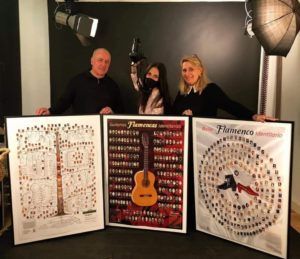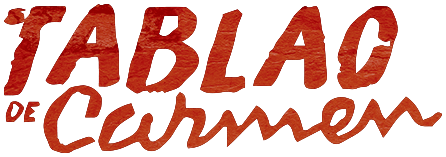Who are the flamenco music artists?
The term “flamenco music” evokes two things first and foremost: flamenco singing and the sound of a flamenco guitar.
The voice of a cantaor (an artist who sings flamenco) is perhaps the first thing that marks flamenco music. And this singing is almost always accompanied by the notes of the flamenco guitar.
The flamenco guitar was born to accompany and inspire flamenco singers. Flamenco is inevitably linked to the image of this musical instrument.
The great poet Federico García Lorca sums up this musical communion in his work La Guitarra – Poema de la seguiriya gitana (Cante Jondo)
Empieza el llanto
de la guitarra.
Se rompen las copas
de la madrugada.
Empieza el llanto
de la guitarra.
Es inútil callarla.
Es imposible
callarla.
Llora monótona
como llora el agua,
como llora el viento
sobre la nevada
Es imposible
callarla,
Llora por cosas
lejanas.
Arena del Sur caliente
que pide camelias blancas.
Llora flecha sin blanco,
la tarde sin mañana,
y el primer pájaro muerto
sobre la rama
¡Oh guitarra!
Corazón malherido
por cinco espadas
Flamenco musicians are the tocaores of the flamenco guitar, the cantaores, and the palmeros, who with their hands and feet mark the compás, the basis of flamenco.
Flamenco music in its beginnings was reduced to three instruments: the voice, the percussion of palmas and feet and the flamenco guitar. And its performers were mostly self-taught and amateur, artists whose personality and artistic gift allowed them to express themselves by singing and playing for select audiences, family or small in numbers, without sound amplification or theatrical technicalities.
As an introduction to the musical performers of flamenco throughout its history, we recommend the magnificent collection of three posters designed by a great flamenco lover, Rafael Garcia Chacón: Cantes flamencos identitarios , Baile Flamenco identitario y Guitarras Flamencas identitarias.

Who are the flamenco dance artists?
To think of Flamenco is to imagine a bailaora (a female flamenco dancer) in a long ruffled dress and flowers in her black hair, or a bailaor (a male flamenco dancer) in a short suit, wearing traditional dance shoes and a Cordovan hat, both next to a guitarist and cantaores with closed eyes and fists or open mouth and arms.
The silhouettes of the flamenco bailaor or bailaora are a classic in the imagery of the flamenco world. Flamenco dance captures the eye of the spectator like few other artistic disciplines. From the flamenco dance we expect the proud gesture of the Spanish character, of the gypsy race, the interpretation of the feeling of the singing and the guitar.
A flamenco dance artist is guided by the compás, the rhythm. Time and rhythm are their raison d’être.
In the history of flamenco, the list of dance artists is innumerable. But in context with the history of Carmen’s Tablao, it is worth mentioning one of the greatest flamenco dancers in history: Carmen Amaya.
Carmen Amaya (Spain, circa 1920 – Bagur, 1963), a purebred gypsy, grew up with her guitarist father and her dancer aunts, dancing and singing from a very young age to make a living in Barcelona, and she triumphed in the great theaters of the world. Her art was indisputable, her personality was overwhelming, and her flamenco style was pioneering, brilliant, original and inimitable.
Who are the flamenco singing artists?
Again, it seems difficult to try to mention only a few singers from the history of flamenco.
The history of flamenco is full of singers who are not professionals, but whose way of singing is classifiable as flamenco by right.
It is necessary to distinguish between the cante adelante or the cante para bailar.
In the former, the cantaor sings alone and freely, with the guitarist to accompany him. In the case of singing for the dance, the cantaor gives himself to the cause and rhythm of the dance, the bailaor being the one who sets the tone for the cante.
It is worth mentioning in this section the existence of the Golden Key of Flamenco Singing Award. This award recognizes those few singers throughout the history of flamenco who have been able to sing all the flamenco styles. It is very difficult for a cantaor to sing well in all the different palos.
Female flamenco artists: an indisputable role
Women in the flamenco world have an important role, and have always been considered a pillar of the tradition.
Mothers are the first to recognize if a child has singing or dancing skills. They are the ones who transmit the basis of musical knowledge through oral culture. The rhythm and the beat are made in the kitchen and on the streets.
The history of flamenco is full of women’s names, of singers and dancers unanimously recognized by all flamenco fans and professionals.
Carmen Amaya, flamenco dancer of universal stature, was baptized as La Capitana, “The Captain” when she was a child. This is the role of many flamenco dancers in history: leaders of families and artistic groups. With great personality and artistic wisdom, they have made flamenco history.
The first scene of Carlos Saura’s iconic feature film Flamenco opens with the powerful close-up of a singing woman: La Paquera de Jerez.
Few scenes sum up so well the weight of a woman in the flamenco scene.
Long live Flamenco, its women and families.
